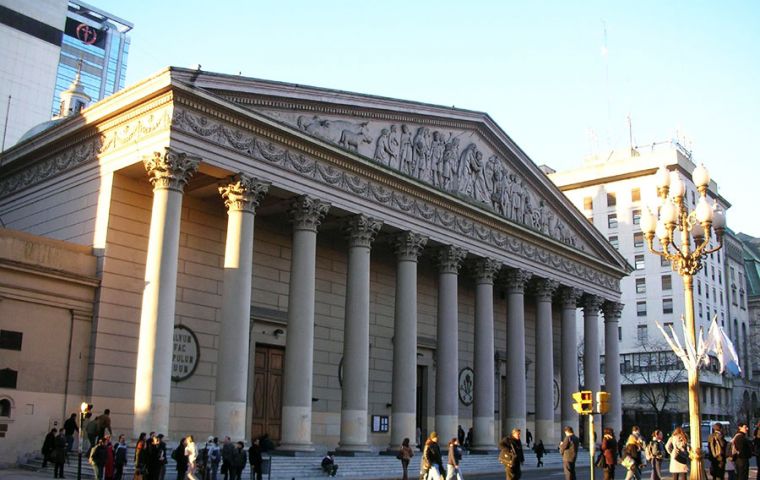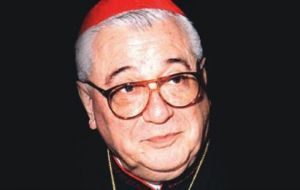MercoPress. South Atlantic News Agency
A unique monument pays tribute to the victims of the AMIA bombing
 On April 19th, 1997, on the 54th anniversary of the Warsaw Ghetto uprising, a memorial mural was inaugurated at the Metropolitan Cathedral of Buenos Aires
On April 19th, 1997, on the 54th anniversary of the Warsaw Ghetto uprising, a memorial mural was inaugurated at the Metropolitan Cathedral of Buenos Aires  The Mural is 1.8m tall by 1.2m wide with two crystals between which prayer book sheets found in Auschwitz, Treblinka and the Warsaw Ghetto are displayed
The Mural is 1.8m tall by 1.2m wide with two crystals between which prayer book sheets found in Auschwitz, Treblinka and the Warsaw Ghetto are displayed  Archbishop of Buenos Aires, Primate of Argentina, Cardinal Antonio Quarracino, endorsed on April 14, 1997, in Buenos Aires, Argentina.
Archbishop of Buenos Aires, Primate of Argentina, Cardinal Antonio Quarracino, endorsed on April 14, 1997, in Buenos Aires, Argentina. By Eduardo Eurnekia - On July 18, 1994, the center of Buenos Aires, the bustling capital of Argentina, was shattered by a huge explosion. A suicide bomber drove his explosives-loaded van into the building of the Jewish Community (AMIA-Asociacion Mutual Israelita Argentina), killing 85 people and injuring hundreds.
This was the deadliest terrorist attack ever in Argentina, with an even higher toll than the previous bombing of the Israeli Embassy in Buenos Aires perpetrated two years earlier.
Commonly attributed to Iran’s intelligence apparatus and its Lebanese proxy Hezbollah, this terrorist attack remains unsolved. Its implications reached a peak in 2015 with the mysterious violent death of Alberto Nisman, an Argentine federal prosecutor who acted as chief investigator of the AMIA case.
Two days after he was found dead, Nisman was going to appear before the Congress to present his case against the then-president of Argentina Cristina Fernandez de Kirchner and senior officials of her administration, claiming they have been colluding with Iran to cover-up the AMIA bombing.
To be sure, the AMIA case is still shrouded with intrigue and mystery, but few people know that it has also brought about the creation of an unprecedented symbol of interreligious fraternity.
On April 19th, 1997, on the 54th anniversary of the Warsaw Ghetto uprising, a memorial mural was inaugurated at the Metropolitan Cathedral of Buenos Aires, the main church of Argentina. This singular memorial is dedicated to the victims of the Holocaust and those who perished in the terrorist attacks perpetrated in Buenos Aires in the 1990s against the Israel Embassy and the AMIA community center, becoming the only monument in a Catholic church, let alone a metropolitan cathedral, fully dedicated to Jews.
A few years earlier, my friend Baruch Tenembaum, founder of the International Raoul Wallenberg Foundation, presented this initiative to the late Cardinal Antonio Quarracino, who at that time was the archbishop of Buenos Aires. After the attack, Quarracino went to visit the ruins of the AMIA building. In the middle of the debris, the cardinal spoke up. His words reverberate in my ears till this very day: “How naïve are the criminals who perpetrated this heinous act. They think they could defeat Judaism”.
Tenembaum asked him to consider the possibility of erecting a memorial mural at the Buenos Aires cathedral, to pay tribute to the Jewish Martyrs of the Holocaust and to those who lost their lives or were maimed as a result of the fatal terrorist attacks perpetrated in the heart of Argentina. Tenembaum told him: “Antonio, the terrorists should know that Catholics and Jews are a family and support each other against all kinds of fanaticism.”
Quarracino’s response was immediate and enthusiastic. Not only that, in a last will and personal letter to Tenembaum, he wrote that he wished to be buried “next to the mural, together with the ashes of his parents,” a clear hint to his desire that the mural will never be moved from the cathedral. He went further by adding that he invites the Jews to visit the mural and “cover their heads if they wish,” a significant gesture, as church visitors are always asked to uncover their heads.
The Mural is 1.8 meters tall by 1.2 meters wide (approximately 6’x4’), composed of two crystals between which prayer book sheets found in Auschwitz, Treblinka and the Warsaw Ghetto are displayed. A Kaddish (the Jewish prayer for the dead) score can also be seen as well as the covers of two books: one of fables in Yiddish, found among the rubble of the AMIA, and another from the Book of Samuel, found in the ruins of the Embassy of Israel in Buenos Aires. The piece is complemented by a copy of the Passover Haggada rescued from a concentration camp in 1942, donated by Miriam Kesler, daughter of one of the victims.
An interior plaque reads: “In memory of our Jewish brothers assassinated and annihilated during the Shoah (Holocaust) and the martyrs of the attacks on the Israeli embassy in Buenos Aires and the Argentine Israelite Mutual Association (AMIA). Archbishop of Buenos Aires, Primate of Argentina, Cardinal Antonio Quarracino, endorsed on April 14, 1997, in Buenos Aires, Argentina.”
On the exterior plaque there is an inscription written by Zvi Kolitz in his work Yosel Rácover Speaks to God: “I believe in the Sun even when it does not shine. I believe in love even when I do not feel it. I believe in God even when he remains silent.
Originally installed in the Chapel of Santa Teresa, at the express request of Monsignor Quarracino the mural was later moved to the Chapel of the Virgin of Luján.
The mural was visited throughout its short history by prominent personalities from Argentina and the world, including president Raúl Alfonsín; president Barack Obama; Cardinals John O’Connor and Angelo Sodano; the archbishops of New York; the secretary of state of the Vatican; Nobel Peace Prize winner Lech Walesa; and the French intellectual Guy Sorman, among others; in addition to the students of numerous schools, and more than 3,000 people who visit the main Catholic temple of Argentina every day.
After the death of Quarracino, his successor, Jorge Mario Bergoglio (better known today as Pope Francis), continued the task of preservation and dissemination of the mural, following the express wish of his mentor and predecessor.
In September 2004, the Raoul Wallenberg Foundation placed a replica of the mural in the Protestant Evangelical Vaterunser Church in Berlin.
Cardinal Antonio Quarracino passed away on February 28th, 1998, less than a year after the inauguration of the mural.
Close to his death, Quarracino confided in us what he knew about the role played by the Catholic Church in saving lives during the Holocaust. Years later, in the framework of the Wallenberg Foundation, we launched the Houses of Life program. In less than five years, our NGO managed to identify more than 500 physical sites in Europe that gave shelter to the victims of the Nazi persecution, mainly children who were left by their parents before the latter were being deported to concentration camps.
Our aim is to place a special plaque on the facade of each House of Life, so that the visitors and passersby learn the stories of heroism that took place beneath their roofs.
It turned out that Cardinal Antonio Quarracino was right. The overwhelming majority of the Houses of Life were Catholic churches, convents, monasteries and boarding schools, giving a clear indication that a well-orchestrated rescue operation was implemented. To what extent Pope Pius XII was involved in this effort remains to be seen. Pope Francis announced the opening of the Vatican secret wartime archives, and we hope that this will shed light on this controversial chapter of history.
In the meantime, we at the International Raoul Wallenberg Foundation feel proud of having contributed to the creation of the memorial mural at the Buenos Aires Cathedral, an unprecedented interfaith symbol.
(*) Eduardo Eunerkian is chairman of The International Raoul Wallenberg Foundation, a New York-based NGO with a mission to preserve the courageous legacy of Raoul Wallenberg and of all the rescuers. Mr. Eunerkian has also been involved in the financing of the Argentine military cemetery in the Falklands and supporting the families of those Argentine combatants buried in the Islands.




Top Comments
Disclaimer & comment rulesCommenting for this story is now closed.
If you have a Facebook account, become a fan and comment on our Facebook Page!